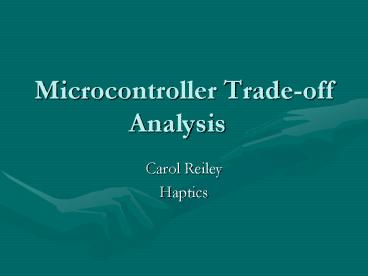Microcontroller Tradeoff Analysis - PowerPoint PPT Presentation
1 / 14
Title:
Microcontroller Tradeoff Analysis
Description:
... timers, UART, SPI, pull-up resistors, pulse width modulation, ... With on-chip in-system programmable Flash and EEPROM, the AVR is a perfect choice ... – PowerPoint PPT presentation
Number of Views:75
Avg rating:3.0/5.0
Title: Microcontroller Tradeoff Analysis
1
Microcontroller Trade-off Analysis
- Carol Reiley
- Haptics
2
Products
- MicroController programmed in assembly or high
level such as basic or C. - Paralax basic stamp
- Microchip Pic Microcontroller
- Atmel's AVR microcontrollers
- Six different models
- System on a chip
- Personal Computer Examples include an IBM PC
compatible or an Apple Mac - Single-Board computer Programmed in high level
language or assembly. Offer more processing
power than microcontroller.
3
Microcontroller
- Inexpensive and have simple power requirements
(usually 5V) - Infield programming and reprogramming
4
System on a Chip
- Pro
- Flexible
- High capabilities
- Con
- New to the lab
- No advanced or experienced users
- Hard to learn
- Uncertain when we will receive them
5
Personal Computers
- Qualities to look for if you plan to use PC as
brains in a no tethered robot. - Small size
- Standard power supply requirements
- Accessibility to microprocessor system bus or an
input/output port - Uni/bidirectional parallel port
- Programmability
- Mass storage capability
- Availability of technical details
6
Single board Computers
- Like junior PCs on a single circuit board
7
Microcontrollers
- Basic Stamp
- Pic
- Atmel AVR 8 bit RISC
8
Paralax Basic Stamp
- Pro
- Easy to learn
- Multithreaded
- Flexible
- -can expand
- Con
- Relatively slower
- Limited
- Cant handle buffers
- More expensive (60-70)
- Great documentation and support
9
Microchip Pic Microcontroller
- Pro
- 20 MHZ
- 4 CPI
- Price(5-10)
- ADC included
- Flexible
- Con
- 10W programming space
- -8Kb program ROM
- Memory page (4 sections)
- Also limited
- Have to pay for compiler
- - buggy
10
Atmel ATmega series
- Price 12-16
- Free compilers
- Support libraries
- Harder to use (not as documented)
- Written in C so hard for incoming seniors
continuing project
11
Atmel Omega Series
- 8 bit RISC Models Analyzed have a RISC core
running single cycle instructions and a
well-defined I/O structure that limits the need
for external components. Internal oscillators,
timers, UART, SPI, pull-up resistors, pulse width
modulation, ADC, analog comparator and watch-dog
timers. AVR instructions are tuned to decrease
the size of the program whether the code is
written in C or Assembly. With on-chip in-system
programmable Flash and EEPROM, the AVR is a
perfect choice - 128
- 32
- 16
12
128
- 128-Kbyte self-programming Flash Program Memory,
4-Kbyte SRAM, 4-Kbyte EEPROM, 8 Channel 10-bit
A/D-converter. JTAG interface for on-chip-debug.
Up to 16 MIPS throughput at 16 Mhz.
13
32
- 32-Kbyte self-programming Flash Program Memory,
2-Kbyte SRAM, 1-Kbyte EEPROM, 8 Channel 10-bit
A/D-converter. JTAG interface for on-chip-debug.
Up to 16 MIPS throughput at 16 Mhz.
14
16
- 16-Kbyte self-programming Flash Program Memory,
1-Kbyte SRAM, 512 Byte EEPROM, 8 Channel 10-bit
A/D-converter. JTAG interface for on-chip-debug.
Up to 16 MIPS throughput at 16 Mhz.































